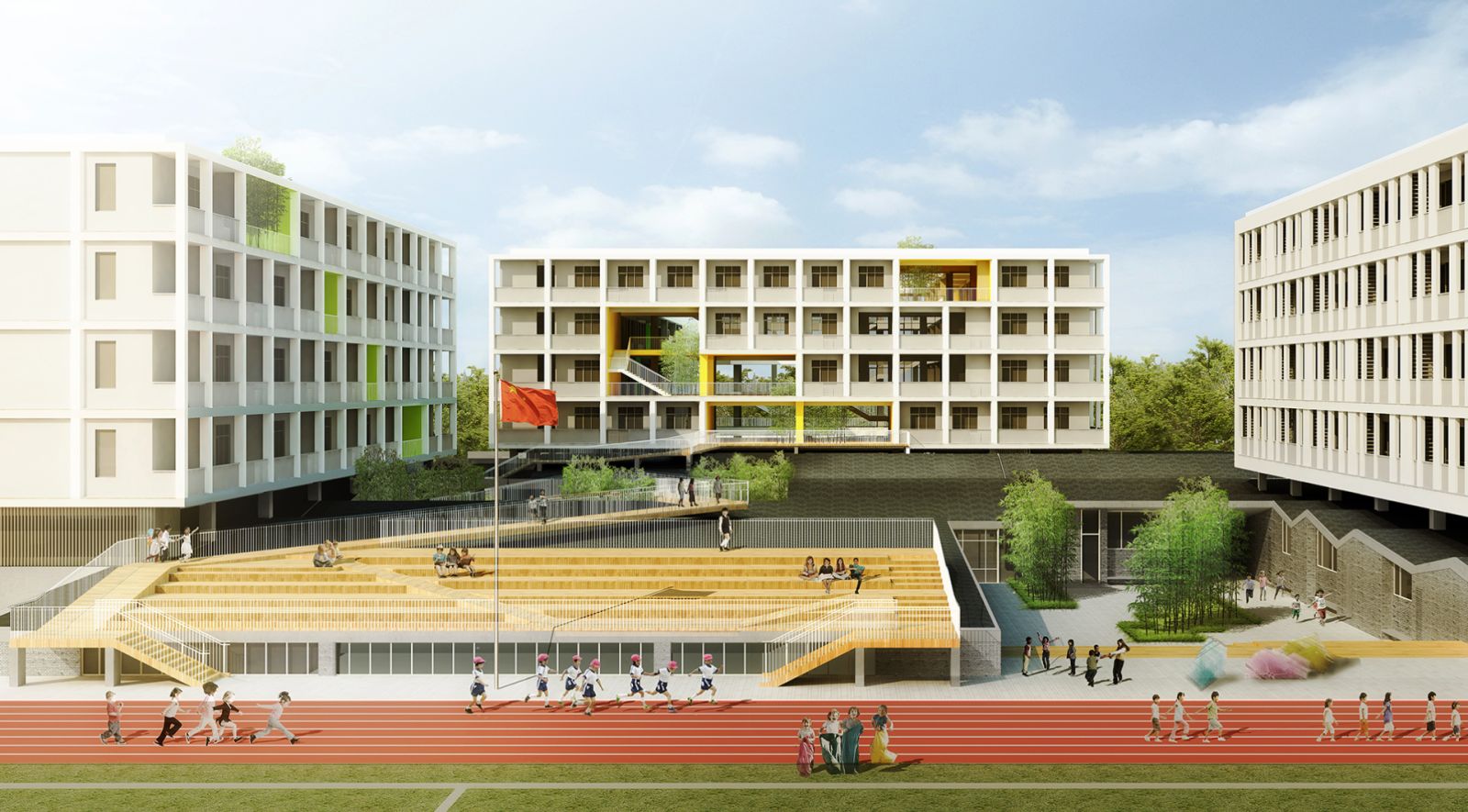Yiwu Foreign Languages School is located in the main urban area of Yiwu, Zhejiang Province. The school, a branch of Hangzhou New Century Foreign Language School in Yiwu, consists of a primary school of 48 classes and a junior high school of 24 classes, now is under construction.
As the first project of returned overseas Chinese, it’s expected to be designed as a cosy and comfortable campus integrated with the international outlook and Yiwu-rooted culture. The design is aimed to create a joyful campus to bring back a sense of intimacy and inspire children’s curiosity, rather than a uniform and solemn general school. Starting with a child’s perspective, the design introduces the “moving”, “communal” and “social” teaching environment to stimulate children’s desire for study and creativity.
Site Plan
The site is a rectangle rotated at 45-degree angle witn the site space is very limited, then the core question of planning lies in how to manage a great amount of teaching units in the limited space, meanwhile, to create rational spatial scale. Each teaching units and spatial module are derived from analyzing about function and volume. Then, the teaching units are organized in a rational and efficient layout, each specially adapted to meet the requirement of the sunlight and ventilation.
Ultimately, the program is generated into two parts. Public space is stretched over the ground floor to stimulate more campus activities. While classrooms, dormitories, playground and other volumes are built on the second floor and above to ensure sufficient sunlight and ventilation. Therefore, the planning strategy not only compact numerous homogeneous space to save more for public, but also fits in the diplomatic concept of educational system.
Lane and Courtyard Derived from Small-scale
The architectural form of the ground floor draws references from Jiangnan watertown buildings with the pitched roof. The spatial units are organized to create a comfortable-scale campus, among which are inserted with “streets”, “lanes”, “courtyards” and “pocket parks” to intensify the sense of community to give the children an open, quiet and comfortable ambience, seeking to trigger their interaction and communication.
On the ground floor, there are laboratories and public classrooms, including other functional spaces including reading rooms, the concert hall, art lounge, dance rooms, art rooms, calligraphy rooms, the experts communication center, the school history room and gallery. These diverse spaces are bonded organically, and centered with courtyards to form thematic courtyards themed with “ knowledge”, “science”, “culture” and “art”. At the same time, the design creates an integral environment, from the perspective of spacial structure, artifact and nature.
Lighthouses in the Sea of Tile
The pitched roofs of the podiums are clad with grey tiles, one of the most common traditional Chinese building materials. The folding roof descends to the ground to subtly combine with the topography, in the place with the most apparent height difference. People could directly wander on the roof of the podiums and perceive the trace and appeal of time passing, which is brought about by layering tiles.
Upper buildings are seemed as the “lighthouses” floating on the “sea of tiles”, forming clear spatial orientation for the campus. The courtyards are echoing the form of upper buildings, which are correlated closely with each other. Therefore, in the journal of walking in the courtyards, people could feel strongly the existence of the upper buildings. Moreover, geometric and visual tension penetrate through the upper and lower space, despite their different levels of scale.
Changable Magic Cube
Differing from continuous ground floor plan, the second floor and above are set in basic rectangular volumes with compacting and efficient space. On the other hand, the rectangular layouts of three classroom buildings center around the courtyards, echoing the courtyard space of the podiums. The international academic exchange center includes offices, training space and a small amount of dining room. The playground can serve as two standard basketball courts to enrich the sport activities. The six-bed student dormitory can accommodate 1890 students totally.
The design of the facade continues the idea of dividing vertically into two parts. The upper buildings appear light and simple with modularized units. While three interfaces of podiums, which is respectively transparent, semi-permeable, and opaque, derived from its spatial characteristic. In addition, the elevated ground floor enhances the sense of floating and lightness emerged from the upper buildings. The project has been officially launched and is expected to be completed in September 2018. Source by LYCS Architecture.
- Location: Yiwu, China
- Architect: LYCS Architecture
- Interior and landscape Design: LYCS Architecture
- Project Team: RUAN Hao, CHEN Wenbin, NIE Yueliang, CHEN Qi
- Collaborators: WU Shiyang, JIANG Leilei, WU Tao, CHEN Zhilin, CAI Zeyu, XU Jun, YANG Ge, XI Shuying, ZHOU Jin
- Size: 85,481 sqm
- Completion: 2019
- Images: Courtesy of LYCS Architecture
